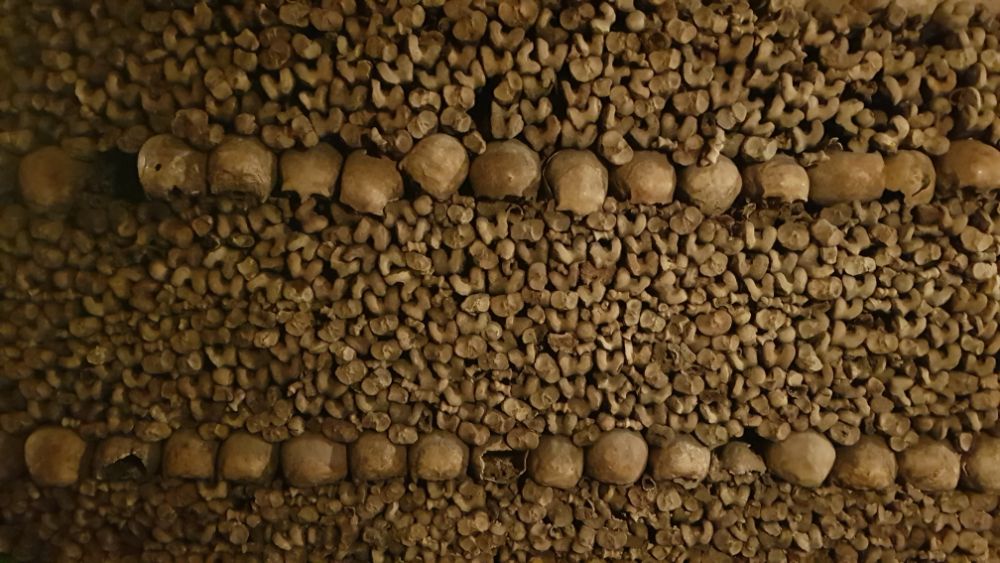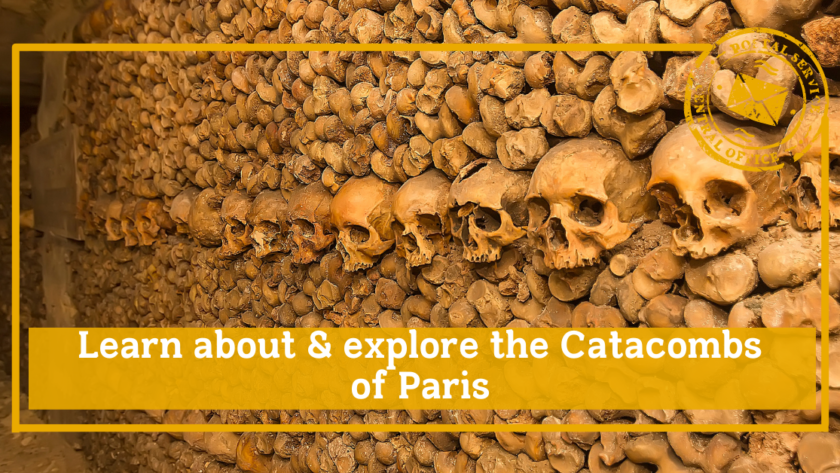One of the more touristic places I went to in France, the Catacombs of Paris still captures my imagination; I’ve always wanted to descend into the depths of this famous ossuary. It’s one of the largest in the world and is surrounded by the bones of over six million people… And it appears I’m not the only one, as it’s one of the more popular things to do when visiting! It seems like a ridiculous notion when you think of it; how there could be so many bones right under your feet that you can go visit? You can walk right up to it and stare at it, almost as if it’s an art installation. It’s technically a museum and is open to the public to visit all year round. Drawing over 500,000 tourists every year to walk through the mile-long section underground.
You only start to sense the gravity of how massive the catacombs are when you look at the map. It took us almost an hour to walk a minuscule amount! You won’t get to see the other 185 miles as most of it is restricted. But it’s not as macabre as it seems! I felt perfectly safe strolling around among the dead and had great fun learning about it.
Whilst you are in Paris, check out some other cheap and quirky things to do here.

History of the Catacombs
The history of the Catacombs is extensive and as you walk along the route you discover all about it. Major health problems in Paris towards the end of the 18th century were found to be linked to the cemeteries. So the decision was made to move all the graves underground to store them. Conveniently enough there were quarries under the area of Montrouge which had been abandoned since the 15th century. Perfect! Plans were set in motion. Louis XVI gave the job to Charles-Axel Guillaumont and in 1785 the first excavations started in the Saints-Innocents cemetery.
As you can imagine, the public didn’t generally like the idea of disturbing their ancestors. Digging up their bones and throwing them all in a quarry had to be done at night to avoid backlash. The Saints-Innocents had been a cemetery for 1,000 years, so it was a big deal.
The work was on and off during the 1800’s but continued through the French Revolution. On April 7th, 1786 the site was officially called “Oussaire municipial de Paris”, gaining the affectionate name the catacombs. During the revolution, people were also buried directly in the catacombs. In 1809 it opened to the public, and in 1860 the last of the bones were laid to rest there. It took 75 years to move everything.
Piles & piles of bones
Before its opening, it needed a little redecorating, and this task was given to Héricart de Thury. He organised the piles of bones into the distinctive walls you immediately think of. Made from shin bones and skulls, they hold the rest of the bones behind. He also wanted the visits to be educational so included cabinets for mineralogy and pathology, along with poetry and religion. The aim was to make you think and reflect on death, not just to ogle at the bones around you. I felt that sense of reflection as I was walking through; thinking about the many various lives the people had led and the story behind each skull. I found myself contemplating the idea of death and my views about it.
By no means did I have an epiphany and emerge into the light as a new person! But it was an appropriate setting to quietly consider these things as you are surrounded by them. When you walk back out blinking in the sunlight the world seems to speed up again. It’s time to go on with the rest of your day.

The Catacombs experience
I visited in February, off-peak season, and the queue wasn’t long, but in the summer it does stretch out. We found ourselves with an extra day in Paris as we had accidentally booked our train a day later. But it all worked out great anyway! At the entrance, everyone goes through the normal security checks. It almost felt like I was lining up for a ride. The little counter on the wall counts the people entering the catacombs, as there are only allowed 200 at a time. I watch the red figures rise as the first people of the day enter.
When it’s eventually our turn we enter through the turnstile with our little group and begin the winding descent down the 131 steps, which carry us 20 metres below. I can feel the temperature drop slightly but it’s not unpleasant and the smell of musty dirt rises to my nostrils, like being in an old church. The group hushes as they slowly walk around the first small room adorned with large educational plaques, telling the history and setting the scene.
Alone in the tunnels
The group disperses as we enter the tunnels, which can fit one person at a time. The hallways seem to stretch on. The lamps on the walls are dim, to preserve everything as much as possible. At every corner, I expect to see the bones at any moment! But it’s still quite some walking until you enter the chambers. If you look up you can see where the rock has been chipped away in the ceiling. Look carefully and you can even find the initials of the workers carved into the stone. Run your hand along the rough walls and you start to feel more connected to this place! Look through the locked gates of old tunnels as you pass and see nothing but pitch-black. I’m not superstitious or religious but I’ve seen way too many horror movies to linger too long in front of them!
The group scatters even more until it feels like it’s only my partner and I wandering these pathways, catching glimpses of someone either in front or behind. Eventually, we pass underneath an open stone doorway and we start to see what we expected – low vaulted ceilings, large ornate tombstones dotted around, and the bones. At first glance, I can scarcely believe there could be so many bones in one place, and then remember that this is only just a fraction of what we can see!
Beauty of the macabre
The shin bones and skulls are artfully arranged along the walls, forming patterns like hearts, and the rest of the bones are piled up behind. It’s such a surreal experience, to be so close to these bones, not knowing who that person was. The way everything is arranged there is no way I could see a whole skeleton, and so parts of people are scattered through the catacombs in many pieces. There’s an excited whisper of voices as there are more informational plaques around and people are gathered around them; no one feels like they can raise their voice above a hushed whisper, and it creates an interesting muffled atmosphere. Everyone else seems lost in their self-reflection too.
It’s hard to deny the beauty of it all – the way the bones are arranged is done with an artistic love. You are not permitted to touch anything or take photos with the flash on, but without it’s fine, and you can get some great shots in here.
It took us over an hour to walk through the catacombs, and that was because we took our time and appreciated what we were experiencing – we knew we would most likely never do it again. But approximately it takes about 45 minutes. My partner is also a keen photographer so it was a unique environment to get some great pictures!
As we ascended the 112 steps of the spiral stone staircase I could see and feel the light as everything became brighter and the voices rose to an excited babble. A security guard at the exit checked our bags, as stealing bones is a thing, and we stepped out, the gift shop on our right and the street on our left. We had escaped the Catacombs.

A fascinating trip to the Catacombs
Experiencing this darker (literally) underground part of Paris is fascinating and I highly recommend paying it a visit. In the summer months, the lines can get pretty lengthy so I recommend buying a ticket beforehand to save the hassle. If you buy them in advance a ticket will cost €14 but if you want to chance it and buy online same-day admission tickets are €24. Not a bad deal if you want to risk it!
The entrance is at 1, avenue du Colonel Henri Rol-Tanguy, 75014, Paris. The nearest metro and train station is Denfert-Rochereau.
The exit is at 21bis, avenue René-Coty, 75014 Paris. It’s just a short walk back to Denfert-Rochereau where you can get the train or metro back into the city.
Learn more about the catacombs and get tickets on their website here.


